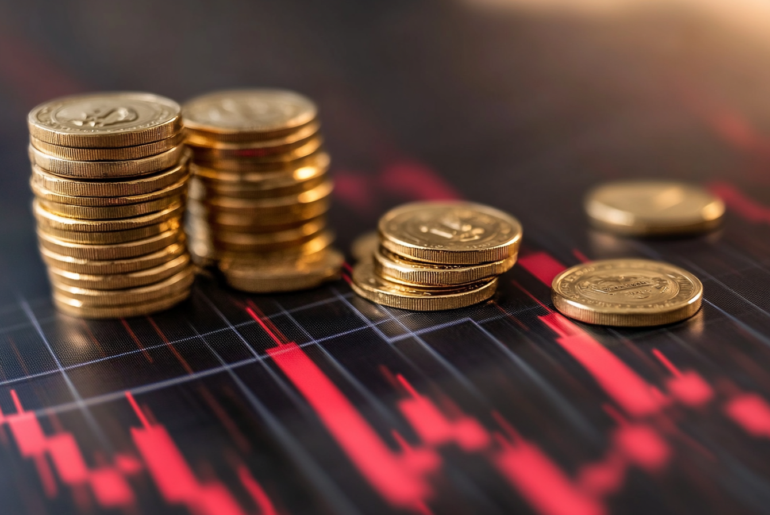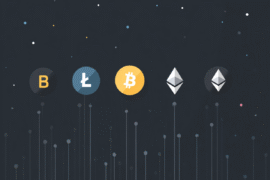This article may contain references to products or services from one or more of our advertisers or partners. We may receive compensation when you click on links to those products or services. Nonetheless, our opinions are our own.
The information presented in this article is accurate to the best of our knowledge at the time of publication. However, information is subject to change, and no guarantees are made about the continued accuracy or completeness of this content after its publication date.
You may have heard more and more warnings about gold lately. Gold is a precious metal that people often see as a safe place to put their money during times of trouble. It’s normal to feel a little worried about your investments when you read news stories about a possible “gold flashing crisis signal.” But before you make any quick choices or give in to fear, you need to take a step back and look at the situation with a clear head. We’ll talk about the signals that are making news right now, the history behind these movements, and why, even though the alarm bells are ringing, there’s no need to panic right away. If you know the details of this situation, you can feel more confident as an investor as you try to figure out what to do.
- The Current Gold Market Dynamics
- Identifying Important Indicators of Economic Health
- Assessing the Role of Gold in Your Investment Strategy
- Practical Steps to Protect Your Portfolio During Uncertainty
- When to Consider Gold as a Hedge Against Inflation
- Embracing a Long-Term Perspective in Times of Market Fluctuation
- Conclusion
- Frequently Asked Questions
- What is the Gold Flashing Crisis Signal?
- Why should investors not panic at this signal?
- What should investors consider before making decisions?
- Are there other indicators to watch besides gold prices?
- What historical examples relate to the current situation?
- How can investors prepare for potential market volatility?
- When might it be time for investors to take action?
- What is the takeaway for investors right now?
- Recommended Reads
The Current Gold Market Dynamics
The current gold market shows a complex interplay of factors that can create a sense of urgency for investors. Geopolitical tensions, inflation rates, and interest rate fluctuations are intertwining in ways that make it essential for you to stay informed. While the price of gold may fluctuate wildly on any given day, it’s important to recognize the larger patterns at work.
For instance, in times of economic uncertainty, gold often serves as a sought-after haven, pushing its value upward. But if the current economic signals shift, you might witness a pullback, leading many to question the stability of their investments.
Here are a few factors to consider:
- Demand Trends: Watch how industrial and jewelry demand changes, especially in emerging markets like India and China.
- Central Bank Policies: Monitor gold purchases by central banks. A surge typically indicates a strategic shift toward gold as an asset.
- Inflation Indicators: As inflation rises, gold could become more appealing, possibly driving prices up.
Gold Market Influence Table:
| Factor | Impact on Gold Prices |
|---|---|
| Geopolitical Stability | Positive correlation, higher demand in uncertainty |
| Interest Rates | Negative correlation, higher rates decrease appeal |
| Market Sentiment | Volatility can lead to speculative activity |
By keeping a close watch on these elements, you can navigate this marketplace with confidence rather than fear.
Identifying Important Indicators of Economic Health
To assess whether the financial landscape is truly perilous or simply in a temporary phase, monitor the following economic indicators:
- Unemployment Rates: A steady or declining rate reflects a healthy job market.
- Consumer Confidence Index: This shows how optimistic consumers are about their financial future, impacting spending.
- Gross Domestic Product Growth: Positive GDP growth typically signals economic strength.
- Inflation Rates: Moderate inflation is typical, but high inflation erodes purchasing power.
- Stock Market Trends: Sustained gains or losses reflect investor sentiment and broader expectations.
Recent Economic Indicator Trends:
| Indicator | Current Status | Trend |
|---|---|---|
| Unemployment Rate | 4.5% | Declining |
| Consumer Confidence Index | 98.5 | Stable |
| GDP Growth | +2.3% | Growing |
| Inflation Rate | 3.1% | Moderate |
| Stock Market Performance | Up 5% YTD | Positive |
By evaluating these indicators alongside gold price movements, you gain a clearer picture of economic health.
Assessing the Role of Gold in Your Investment Strategy
Gold can help diversify your portfolio and serve as a buffer against volatility.
Here’s why you might include it:
- Inflation Hedge: Gold often retains its value during inflation, protecting purchasing power.
- Portfolio Diversification: It moves independently from stocks and bonds, reducing overall risk.
- Historical Stability: Gold has consistently retained value over time.
Many financial experts recommend allocating 5 to 10% of your portfolio to gold, depending on your goals and risk tolerance.
Sample Asset Allocation Table:
| Asset Type | Recommended Allocation (%) |
|---|---|
| Stocks | 60 |
| Bonds | 30 |
| Gold | 5 to 10 |
| Cash | 5 to 10 |
Incorporating gold thoughtfully into your investment mix enhances financial resilience without overexposure.
Voted "Best Overall Budgeting App" by Forbes and WSJ
Monarch Money helps you budget, track spending, set goals, and plan your financial future—all in one app.
Get 50% OFF your first year with code MONARCHVIP
Practical Steps to Protect Your Portfolio During Uncertainty
Proactive planning is crucial during uncertain times.
Here are practical strategies:
- Diversify: Spread investments across sectors, asset types, and regions.
- Maintain an Emergency Cash Reserve: Keeps you liquid and able to act during downturns.
- Rebalance Regularly: Ensure your portfolio aligns with your goals and risk tolerance.
- Stay Informed: Follow credible sources, but don’t overreact to daily headlines.
Portfolio Protection Actions:
| Action | Benefit |
|---|---|
| Diversify | Reduces risk |
| Cash Reserve | Provides liquidity |
| Rebalance | Mitigates overexposure |
| Stay Informed | Supports sound decision-making |
These strategies offer stability and perspective during market shifts.
When to Consider Gold as a Hedge Against Inflation
There are specific economic scenarios where gold becomes especially useful:
- Persistent Inflation Trends: A continuous rise in consumer prices could signal it’s time to invest in gold.
- Economic Uncertainty: Political or market instability enhances gold’s safe-haven appeal.
- Low or Negative Real Interest Rates: Increases gold’s attractiveness as a store of value.
- Currency Depreciation: Helps preserve your purchasing power when local currencies weaken.
Inflation Hedge Allocation Table:
| Economic Indicator | Gold Allocation (%) |
|---|---|
| Inflation Rate > 3% | 5 to 10 |
| Negative Real Interest Rates | 10 to 15 |
| Geopolitical Tensions | 10 to 20 |
| Currency Value Decline | 10 to 15 |
Use this guide to adjust your portfolio based on inflationary pressures.
Embracing a Long-Term Perspective in Times of Market Fluctuation
Reacting emotionally to market turbulence can hurt long-term growth. Instead:
- Revisit Your Financial Goals: Make sure you know what you want, such as retirement, buying a home, or going to school, and stay on track.
- Diversify Your Portfolio: Mitigates losses by spreading risk.
- Stay Informed: Trusted sources can keep you grounded in facts.
Historical Market Recovery Table:
| Year | Market Decline (%) | Recovery Time (Years) |
|---|---|---|
| 2000 | -24 | 3 |
| 2008 | -37 | 4 |
| 2020 | -34 | 1 |
This data shows markets recover, and patience is often rewarded.
Conclusion
When the market changes and the “gold flashing crisis signal” gets people’s attention, it’s important to remember that gold prices don’t always mean that financial instability is about to happen. They can be affected by a number of things, including geopolitical events, inflation, and interest rates. You can deal with these changes in the market more easily if you know how gold works and how it fits into your portfolio. Gold can help protect against inflation and add variety to your portfolio, but it’s important to keep a long-term view and not let short-term market changes affect your emotions. To manage risk and take advantage of opportunities during uncertain times, you should take proactive steps like diversifying your investments, staying informed, and reviewing your portfolio on a regular basis. You can get through ups and downs without losing sight of your long-term goals if you keep your financial goals in mind. When the market is unstable, being patient, having a plan, and managing your risks well will help you make smart investment choices.
Frequently Asked Questions
What is the Gold Flashing Crisis Signal?
It refers to sharp movements in gold prices that some analysts interpret as warnings of financial instability. When gold spikes, investors may be seeking safety in tangible assets.
Why should investors not panic at this signal?
Gold prices rise for many reasons—geopolitical tension, inflation concerns, and monetary policy, not all of which imply an immediate crisis. Broader context matters.
What should investors consider before making decisions?
Review your financial goals, risk tolerance, and overall strategy. Diversification and professional advice help avoid impulsive reactions.
Are there other indicators to watch besides gold prices?
Yes. Watch interest rates, inflation, unemployment, and stock market performance to understand the broader economy.
What historical examples relate to the current situation?
Gold surged during the 2008 crisis and the early COVID-19 pandemic. But prices also rise from unrelated shifts like currency movements or portfolio rebalancing trends.
How can investors prepare for potential market volatility?
Maintain a diversified portfolio, build an emergency fund, and create a long-term investment strategy that includes contingency planning for downturns.
When might it be time for investors to take action?
Act if multiple economic indicators point to broad instability, not just a gold spike. Watch for sustained declines, major policy changes, or systemic risks.
What is the takeaway for investors right now?
Stay informed, not fearful. Monitor the market, review your strategy, and avoid rash decisions. Panic often leads to missed opportunities.

Reviewed and edited by Albert Fang.
See a typo or want to suggest an edit/revision to the content? Use the contact us form to provide feedback.
At FangWallet, we value editorial integrity and open collaboration in curating quality content for readers to enjoy. Much appreciated for the assist.
Did you like our article and find it insightful? We encourage sharing the article link with family and friends to benefit as well - better yet, sharing on social media. Thank you for the support! 🍉
Article Title: Gold Prices: Is the Market Crisis Already Here?
https://fangwallet.com/2025/08/04/gold-prices-is-the-market-crisis-already-here/The FangWallet Promise
FangWallet is an editorially independent resource - founded on breaking down challenging financial concepts for anyone to understand since 2014. While we adhere to editorial integrity, note that this post may contain references to products from our partners.
The FangWallet promise is always to have your best interest in mind and be transparent and honest about the financial picture.
Become an Insider

Subscribe to get a free daily budget planner printable to help get your money on track!
Make passive money the right way. No spam.
Editorial Disclaimer: The editorial content on this page is not provided by any of the companies mentioned. The opinions expressed here are the author's alone.
The content of this website is for informational purposes only and does not represent investment advice, or an offer or solicitation to buy or sell any security, investment, or product. Investors are encouraged to do their own due diligence, and, if necessary, consult professional advising before making any investment decisions. Investing involves a high degree of risk, and financial losses may occur including the potential loss of principal.
Source Citation References:
+ Inspo
Białkowski, J., Bohl, M. T., Stephan, P. M., & Wisniewski, T. P. (2015). The gold price in times of crisis. International Review of Financial Analysis, 41, 329-339.











































